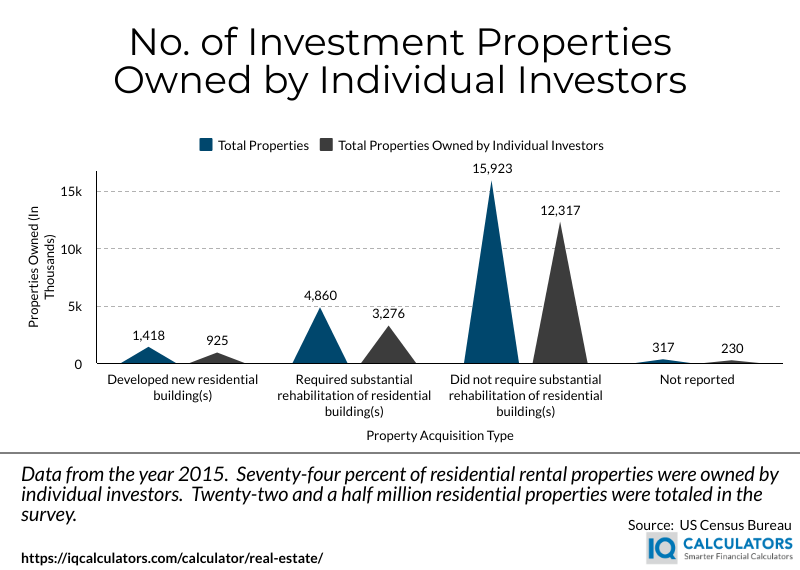Are you thinking of investing in real estate? If so, then there are certain real estate calculations that every real estate investor should know.
People need to know real estate calculations and metrics because these are the metrics that you will use to decide between two mutually exclusive investment options...."Investment A" or "Investment B."
Here is a list of real estate metrics discussed in this article:
- Cash on Cash Return
- Equity Build-Up Rate
- Net Present Value of Future Cash Flows
- Capitalization(Cap) Rate
- Internal Rate of Return
- Net Operating Income
- Price to Rent Ratio
- Debt Service Coverage Ratio
- Break-Even Ratio
- Rent Per Square Foot
- Loan to Value Ratio
1) Cash on Cash Return
Cash on cash return is a comparison between cash flow in year one relative to the initial cash investment in the property in year one. This calculation, where year one cash flow gets divided by the initial cash investment, is called the "year one cash on cash return."
Equation: Year 1 Cash Flow / Year 1 Capital Expenses
Example: "Property A" requires an initial cash investment in the form of a down payment on the mortgage, renovation costs, and brokerage fees of $10,000 and will bring in $2,400 of year one annual cash flow. While "Property B" requires a similar initial cash investment except it is $20,000 and is estimated to bring in $3,600 of cash flow annually. The second one may seem better at first since the annual cash flow will be larger. However, when compared to the initial cash outlay for each property, the first property has a better "Cash on Cash Return." The first example's year one cash on cash return is 24%, while the second is 18%.
Important Tip #1: Cash on cash return should only be used in year 1 as it is not a time value of money calculation. If you were to calculate return in year 2 and beyond, adjustments for the time value of money would need to be made.
Important Tip #2: Cash flow is affected by income taxes. And income taxes are affected by depreciation expense. Be sure to subtract this non-cash expense from income before calculating income tax.
2) Equity Build-Up Rate
Not all of an investor's return will come back in the form of cash flow. Some of the returns will come from the build-up of equity in the investment property. That is where the equity build-up rate becomes useful.
The equity build-up rate is calculated similarly to the cash on cash return in that it is the equity built up in year one via principal mortgage payments, divided by the initial cash outlay invested in the property.
Equation: Year 1 Equity Build Up / Year Capital Expenses
Example: Let's say a real estate investor's projected initial outlay, including down payment and renovation costs, was $20,000 while the property purchase price was $100,000. We recommend that the principal paid on the mortgage in year one gets calculated with a mortgage calculator, but for purposes of this calculation, let's say $1,000 of principal gets paid on the mortgage in year 1. Based on these numbers, dividing $1,000 by the $20,000 of initial investment, this equals a 5% equity build-up rate.
Important Tip #1: Similar to cash on cash return, this is a year 1 measurement and should not be used in year 2 and beyond.
Important Tip #2: The equity build up rate and the cash on cash return can be added together so that it calculates a total return between the cash and equity received in year 1.

3) Net Present Value of Future Cash Flows
The net present value of future cash flows from real estate is not a simple calculation. Two things are needed to calculate the net present value. First, what is the discount rate or cost of money(also known as the required rate of return), and second, what are the projected future net cash flows? Apart from an excellent real estate investment calculator, this one would be very time-intensive to calculate.
This formula is calculated by taking projected or estimated future net cash flows and discounting them back to the present value at the discount rate chosen. It is useful to have an understanding of the time value of money to grasp this calculation.
The formula for discounting each future year's net cash flow is:
Equation: NPV = ∑{Net Period Cash Flow / (1+ R)^T}
Where T equals Time, and R equals the discount rate chosen. As can be seen from the formula, the further out cash flow is in time, the smaller it will become when the discount rate is applied to calculate the present value of the future cash flow. This fact is because cash flows further out in time are worth less than cash flows that are closer to the present.
Important Tip #1: When discounting back to the present value, if the NPV is positive, that means the return on investment is greater than the discount rate used to discount the cash flows. If it is negative, then the ROI is less than the discount rate used to discount the cash flows.
4) Capitalization(Cap) Rate
This calculation is a crowd favorite in the world of real estate. That is because it is a fairly quick and easy way to compare two rental properties. It's also useful to be able to track trends in the rental market as many investors follow this metric.
All one needs to do to calculate this is to estimate one's net operating income. Or, if it is ownership in an existing property, use actual numbers to calculate net operating income. Then divide net operating income by the property value.
Important Tip #1: A good capitalization rate depends on several different factors. Capitalization rates will differ by geographical markets, and between time periods. What is a good capitalization rate today may not be a good capitalization rate several years from now, relatively speaking.
5) Internal Rate of Return (ROI or Return on Investment)
Internal rate of return(IRR) on real estate is a close cousin to the net present value of real estate cash flows talked about above. IRR is also not a simple calculation.
Whereas cash on cash return and equity build-up rate calculations are useful only in year 1, IRR considers the time value of money, and it can get used in any year that the real estate investor chooses. As mentioned above, IRR is sometimes known or referred to as an investor's annualized rate of return.
Equation: 0 = CF0 + CF1/(1 + IRR) + CF2 / (1 + IRR)2 + CF3 / (1+ IRR)3....
Important Tip #1: How are NPV and IRR related? They are related because at the very discount rate that causes the net present value calculation to equal zero, this will be internal rate of return's solution. In other words, IRR equals the discount rate the makes NPV equal zero.
Important Tip #2: This calculation is complicated. Rather than waste time, it's better to use a rental property calculator like the one found here.
Important Tip #3: This calculation(also known as an "annualized rate of return") can be used to compare across different asset classes such as the stock market, etc. This is assuming that your real estate projections and estimates are accurate.

6) Net Operating Income
Net operating income is calculated by taking total revenue from gross rents and subtracting all operating expenses. Operating expenses include items such as maintenance and vacancy allowance. But it excludes capital items such as principal and interest payments and depreciation expense.
Equation: Net Operating Income = Total Revenue From Gross Rents - Total Operating Expenses
Important Tip #1: In the accounting world, net operating income is also known as EBITDA. (Earnings Before Interest, Taxes, Depreciation, and Amortization)
7) Price to Rent Ratio
The price to rent ratio is simply the purchase price of the property divided by the amount of rent you expect to receive each year before expenses. This formula creates a useful metric between comparable properties to determine which presents a better value to the investor.
Equation: Price to Rent Ratio = Price of Property / Rental Revenue Per Year
Important Tip #1: This metric is done differently among different investors. Some people like to flip the ratio and call it Rent to Price/Cost Ratio. Other only use rental revenue from one month instead of a full year. Regardless, the important thing is to remain consistent.
Important Tip #2: This ratio is also sometimes referred to as the Gross Rent Multiplier. We like to call things what they are, as it adds clarity and reduces need for explanation.
8) Debt Service Coverage Ratio (DSCR)
The debt service coverage ratio measures the rental income against the debt payments from the mortgage. In other words, it divides the net operating income(rental revenue minus operating expenses)by the mortgage payment. This measures how much of a cushion there is between the income and the mortgage payment.
Equation: Debt Service Coverage Ratio = Net Operating Income / Debt Payment
Important Tip #1: Use annual or monthly numbers. However, annual numbers may smooth out one time operating expenses if there are any.
Important Tip #2: This ratio will be important to lenders for obvious reasons.
9) Break-Even Ratio
The break-even ratio is sometimes also called the break-even occupancy ratio. It is the sum of annual operating expenses and mortgage expenses divided by projected yearly rental income. By dividing these expenses by the projected rental income, it will tell you what proportion of the property must get rented out to break even.
Equation: Break Even Ratio = (Total Operating Expenses + Total Debt Service) / (Projected Rental Income)
Important Tip #1: The break even ratio becomes more important when purchasing a multi-family investment such as an apartment complex. It may not be as relevant for a single family home.

10) Rent Per Square Foot
By calculating the projected rent per square foot, this is a straightforward metric that can get used when comparing investment properties.
Equation: Rent Per Square Foot = Gross Rent / Square Footage of Property
Important Tip #1: One could also divide rent per square foot by the price per square foot to make a comparison. This would be similar to the price to rent equation listed above.
Important Tip #2: The square footage of the property can vary depending on methodology used. One could use livable square foot, total square foot, or some other variation. The key is to be consistent between properties.
11) Loan to Value Ratio
The loan to value ratio gets used to calculate the amount of debt someone has relative to the value of their property. The lower the ratio, the better, in terms of having less debt relative to the asset.
Equation: Loan to Value = Debt Outstanding / Value of Property
Important Tip #1: The loan to value ratio can decrease one of two ways. 1) Debt can go down. 2) Property value can go up.
Conclusion
If real estate investing is what you do, it's essential to understand real estate investing formulas and calculations such as these. If an investor understands and knows these calculations, they will be on their way to making better financial decisions when buying rental property.
Calculators That Can Help

